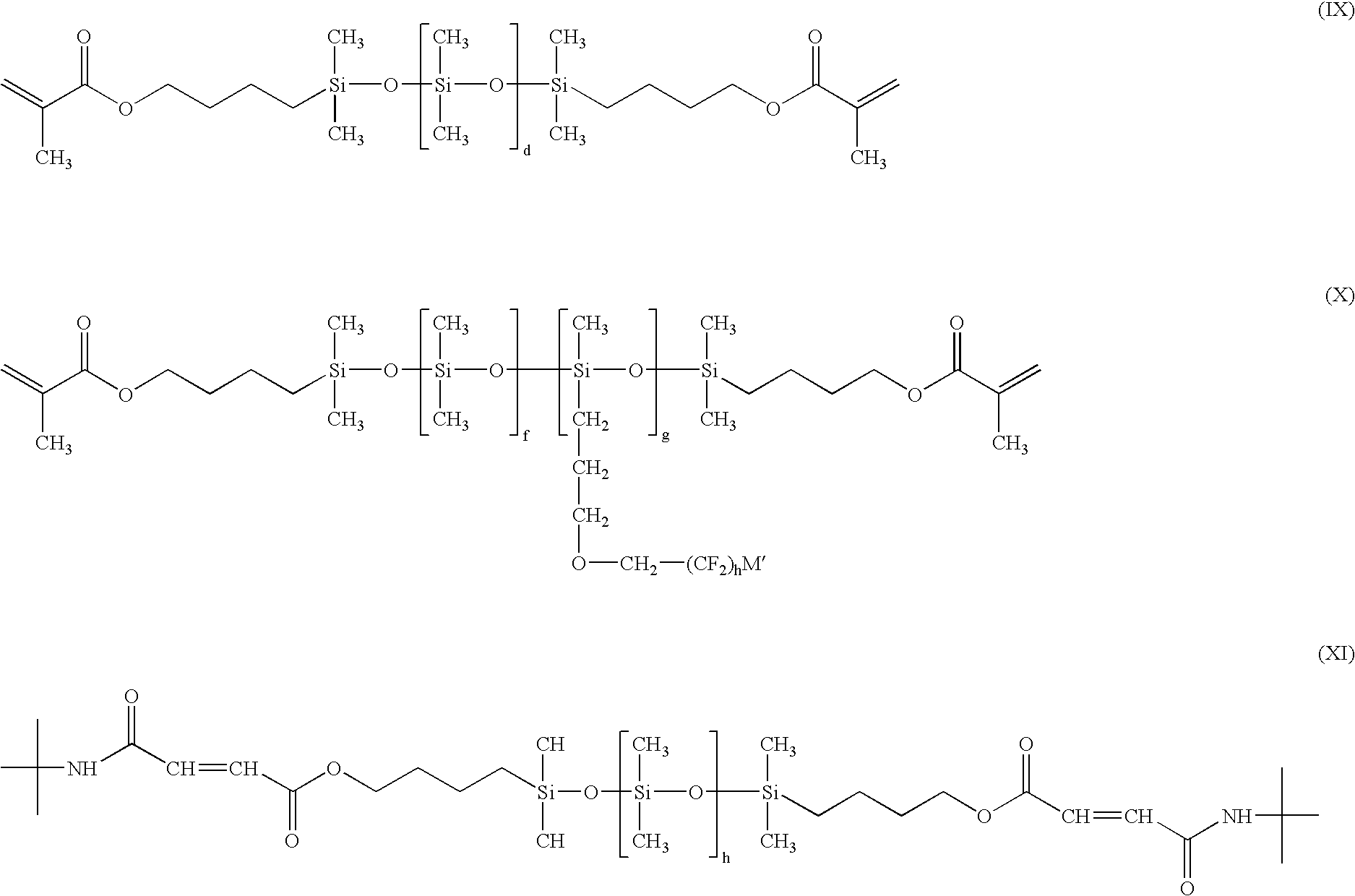Method for making biomedical devices
a biomedical device and silicone hydrogel technology, applied in the field of silicone hydrogel biomedical devices, can solve the problems of human cornea damage, non-uniform monomer mixture, and incompatibility of silicone-containing monomers with hydrophilic monomers, and achieve the effect of reducing the cloudiness of the mixtur
- Summary
- Abstract
- Description
- Claims
- Application Information
AI Technical Summary
Benefits of technology
Problems solved by technology
Method used
Image
Examples
example 1
Preparation of α,ω-bis(4-hydroxybutyl)polydimethylsiloxane (Mn about 5000)
[0086] The following were charged to a 2-L, three-neck round-bottom flask equipped with one reflux condenser: 51.26 grams of 1,3-bishydroxybutyl tetramethyldisiloxane; 1085 grams of dimethoxydimethylsilane; 157.8 grams of distilled water; and 18.4 mL of concentrated hydrochloric acid. The mixture was heated at 60° C. for 1 hour. Methanol was then distilled off over a 5-hour period, with 552 mL collected. Then, 349 ml distilled water and 349 mL concentrated HCl were added, and the contents were refluxed at 100° C. for 3 hours. The crude product was then separated from the aqueous layer. Then, 600 mL diethyl ether (ether) and 400 mL deionized water were added, and the solution was extracted twice with 400 mL sodium bicarbonate solution (0.5%) and then with distilled water until the washing had neutral pH. The product (655.8 grams) was then added slowly into a mixture of methanol / water (508.2 g / 147.97 g). The bo...
example 2
Preparation of a Polydimethylsiloxane-Based Prepolymer Using PDMS of Example 1
[0087] A dry 3-neck, 500-mL round-bottom flask was connected to a nitrogen inlet tube and a reflux condenser. The following were added to the flask all at once: isophorone diisocyanate (7.825 g, 35.202 mmol) (IPDI); α,ω-bis(4-hydroxybutyl)polydimethyl-siloxane (94.31 g, 19.648 mmol) from Example 1; dibutyl tin dilaurate (0.297 g); and 250 mL methylene chloride. The contents were refluxed, and after overnight, the amount of isocyanate was determined to decrease to 44.5% by titration. Then diethyleneglycol (1.421 g, 13.391 mmol) (DEG) was added to the flask. The refluxing was continued overnight, and the amount of isocyanate decreased to 5.1% of the original as determined by titration. Then the contents were cooled down to ambient temperature. 1,1′-bi-2-phenol (0.013 g) and 2-hydroxyethyl methacrylate (0.819 g, 6.293 mmol) were then added and the contents were stirred at ambient until isocyanate peak at 226...
example 3
Casting of Silicone Hydrogels from Monomer Mixture Comprising Polysiloxane-Based Prepolymer and Hydrophilic Monomer
[0088] A monomer mixture was prepared by mixing the following components (where “pbw” denotes “parts by weight” and “ppm” denotes “parts per million”): the polydimethylsiloxane-based prepolymer of Example 2 (65 pbw); methacryloxypropyl tris(trimethylsiloxy)silane (TRIS, 10 pbw);); N,N-dimethylacrylamide (DMA, 25 pbw); n-hexanol (10 pbw); Darocur-1173™ UV photo initiator (0.5 pbw) (available from Ciba Specialty Chemical, Ardsley N.Y.); and 1,4-bis(2-methacrylamidoethylamino) anthraquinone as a tint (150 ppm). The monomer mixture appeared clear, was cast between pairs of silane-treated glass plates, and then exposed to UV light for one hour to cure the monomer mixtures in the form of clear films. The pairs of glass plates were separated by Teflon™ polymer tapes of different thicknesses to obtain a series of films with thicknesses of about 200, 400 and 600 microns. The c...
PUM
| Property | Measurement | Unit |
|---|---|---|
| molar ratio | aaaaa | aaaaa |
| weight percent | aaaaa | aaaaa |
| weight percent | aaaaa | aaaaa |
Abstract
Description
Claims
Application Information
 Login to View More
Login to View More - R&D
- Intellectual Property
- Life Sciences
- Materials
- Tech Scout
- Unparalleled Data Quality
- Higher Quality Content
- 60% Fewer Hallucinations
Browse by: Latest US Patents, China's latest patents, Technical Efficacy Thesaurus, Application Domain, Technology Topic, Popular Technical Reports.
© 2025 PatSnap. All rights reserved.Legal|Privacy policy|Modern Slavery Act Transparency Statement|Sitemap|About US| Contact US: help@patsnap.com



